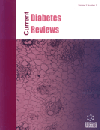Current Diabetes Reviews - Volume 10, Issue 1, 2014
Volume 10, Issue 1, 2014
-
-
Assessment of Pancreatic β-Cell Function: Review of Methods and Clinical Applications
More LessType 2 diabetes mellitus (T2DM) is characterized by a progressive failure of pancreatic β-cell function (BCF) with insulin resistance. Once insulin over-secretion can no longer compensate for the degree of insulin resistance, hyperglycemia becomes clinically significant and deterioration of residual β-cell reserve accelerates. This pathophysiology has important therapeutic implications. Ideally, therapy should address the underlying pathology and should be started early along the spectrum of decreasing glucose tolerance in order to prevent or slow β-cell failure and reverse insulin resistance. The development of an optimal treatment strategy for each patient requires accurate diagnostic tools for evaluating the underlying state of glucose tolerance. This review focuses on the most widely used methods for measuring BCF within the context of insulin resistance and includes examples of their use in prediabetes and T2DM, with an emphasis on the most recent therapeutic options (dipeptidyl peptidase-4 inhibitors and glucagon-like peptide-1 receptor agonists). Methods of BCF measurement include the homeostasis model assessment (HOMA); oral glucose tolerance tests, intravenous glucose tolerance tests (IVGTT), and meal tolerance tests; and the hyperglycemic clamp procedure. To provide a meaningful evaluation of BCF, it is necessary to interpret all observations within the context of insulin resistance. Therefore, this review also discusses methods utilized to quantitate insulin-dependent glucose metabolism, such as the IVGTT and the euglycemic-hyperinsulinemic clamp procedures. In addition, an example is presented of a mathematical modeling approach that can use data from BCF measurements to develop a better understanding of BCF behavior and the overall status of glucose tolerance.
-
-
-
Role of Endogenous GLP-1 and its Agonists in Osteopenia and Osteoporosis: But We Little Know Until Tried
More LessThe present brief review looks at the evidence on the role of GLP-1 and its agonists in osteopenia and osteoporosis in type 2 diabetes (T2DM). There is accumulating data to suggest a favourable effect of GLP-1 on bone metabolism. However, most data is from experimental studies, while clinical confirmation is still inadequate. Moreover, little is known on the precise mechanisms underlying these effects. Therefore, we need randomised clinical trials in T2DM patients to learn more on the action of GLP-1 on bone metabolism and its potential clinical implications.
-
-
-
Momordica charantia and Type 2 Diabetes: From in vitro to Human Studies
More LessAuthors: Sandra D. Habicht, Christine Ludwig, Ray-yu Yang and Michael B. KrawinkelType 2 diabetes is a growing health problem worldwide that is particularly severe in India and China. In these areas, bitter gourd (Momordica charantia) is a popular vegetable which is traditionally known to have health beneficial effects not only, but mainly, on diabetes. Bitter gourd could be a cheap possibility to help the poor in these and other countries to control their blood glucose levels. This review describes anti-diabetic effects of bitter gourd reported in the literature and discusses what still needs to be clarified for developing an evidence-based and safe use of the bitter gourd for diabetes. Analyses of bioactive compounds have shown that bitter gourd is rich in nutrients and phytochemicals of which some have anti-diabetic effects. Juices, powders, extracts, and isolated compounds have been tested in vitro and in vivo. Bitter gourd increases insulin secretion of the pancreas, decreases intestinal glucose uptake, and increases uptake and utilization of glucose in peripheral tissues. Although human studies with type 2 diabetics are weak in their design and/or results, some of the studies do indicate anti-diabetic effects in patients and safety for bitter gourd treatment in humans. In the future, well designed studies with rodents will help to understand what kind of bitter gourd variety, dosage, preparation, and duration of administration is optimal. Such results will help to design human studies which are necessary to prove the effectiveness of bitter gourd in patients.
-
-
-
Review of Erectile Dysfunction in Diabetic Animal Models
More LessAuthors: Serap Gur, Taylor C. Peak, Philip J. Kadowitz, Suresh C. Sikka and Wayne J.G. HellstromErectile dysfunction (ED) is a common, male sexual disorder that has a negative impact on the quality of life of men and their sexual partners. The prevalence of ED in diabetic men is ≥50%. Animal models provide a valuable perspective in the investigation of ED. Most basic science studies have utilized the rodent model of type 1 diabetes. However, an animal model for type 2 diabetes-associated ED requires verification. The streptozotocin (STZ) induced type 1 diabetic model has contributed to significant advancement in the study of ED. A Medline search using the keywords "diabetic animals and ED" was performed, and available peer-reviewed English articles between 2007-2013 were evaluated. The proposed mechanisms for developing ED in diabetics include: hyperglycemia, impaired nitric oxide (NO) synthesis, cyclic guanosine monophosphate (cGMP) pathway dysfunction, increased levels of reactive free-radicals, up-regulation of the RhoA/Rho-kinase pathway, and neuropathic damage. The current treatment regimen of diabetes-induced ED is multimodal. Modification of comorbidities and, specifically, rectifying the underlying hyperglycemia is vital to prevent or halt progression of the disease. Further research on the basic mechanisms of ED and additional studies using better animal models of ED associated with type 1 and 2 diabetes are needed. Preclinical studies using the diabetic animal model will likely provide further insight for intervention and prevention strategies for diabetic ED treatment.
-
Volumes & issues
-
Volume 21 (2025)
-
Volume 20 (2024)
-
Volume 19 (2023)
-
Volume 18 (2022)
-
Volume 17 (2021)
-
Volume 16 (2020)
-
Volume 15 (2019)
-
Volume 14 (2018)
-
Volume 13 (2017)
-
Volume 12 (2016)
-
Volume 11 (2015)
-
Volume 10 (2014)
-
Volume 9 (2013)
-
Volume 8 (2012)
-
Volume 7 (2011)
-
Volume 6 (2010)
-
Volume 5 (2009)
-
Volume 4 (2008)
-
Volume 3 (2007)
-
Volume 2 (2006)
-
Volume 1 (2005)
Most Read This Month


